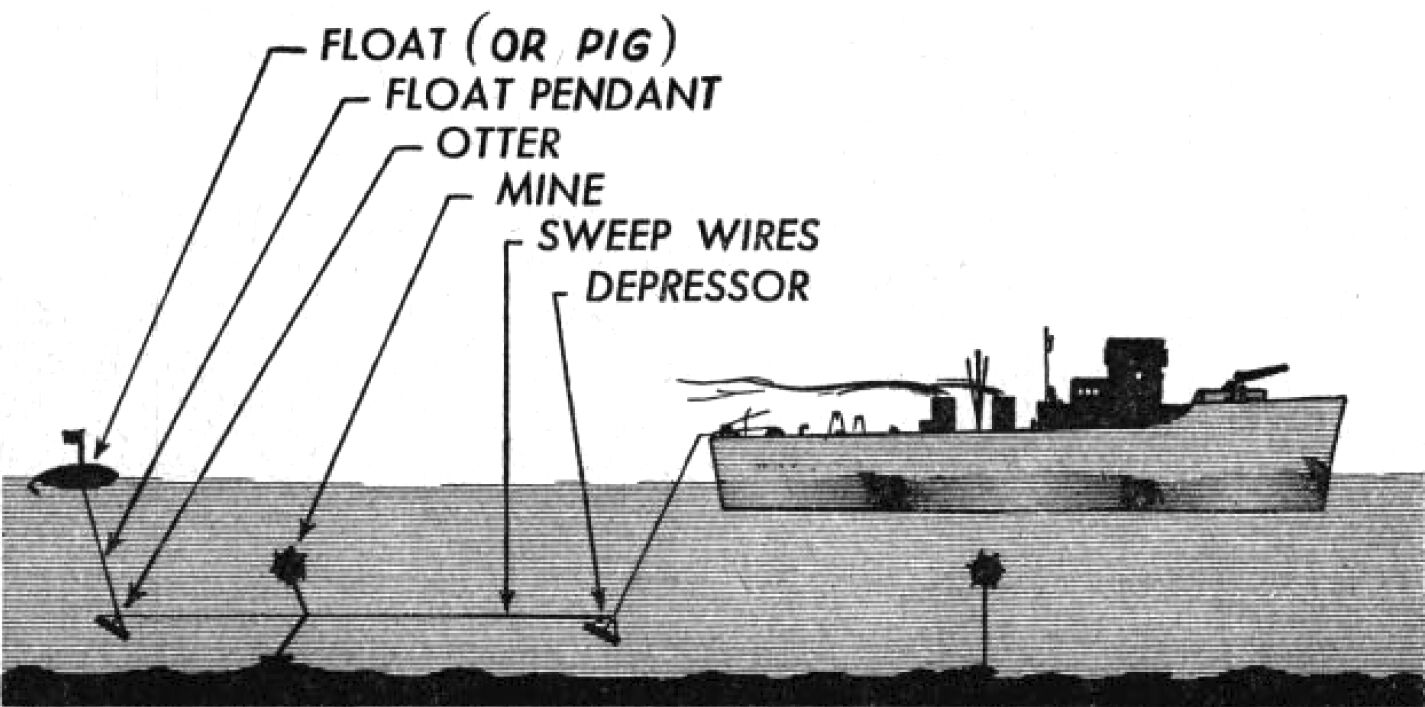The following article on minesweepers of WW2 is an excerpt from Barrett Tillman’ D-Day Encyclopedia. It is available for order now from Amazon and Barnes & Noble.
Minesweepers
Among more than five thousand Allied ships and landing craft deployed to Normandy were 255 minesweepers. They were usually small wooden-hulled vessels, often converted trawlers, specially equipped to ‘‘sweep’’ anchored mines by cutting their mooring ropes or chains, permitting the mines to float to the surface where they could be destroyed by gunfire.
Magnetically activated ‘‘influence’’ mines were defeated with a strong electrical current passed through a loop of cable, neutralizing the detonator. Acoustic mines, which responded to the noise of a ship’s engines and propellers, were prematurely detonated by underwater noisemakers operating on suitable harmonic frequencies.
Pressure mines were the most difficult to sweep, especially when they were anchored on the bottom in fairly shallow water. One marginally effective method was the Sterling Craft, resembling a giant garden trellis. Towed at a suitable depth, it was expected to generate enough overpressure to detonate the mine but survive the explosion, the force of which would pass through the iron lattice pattern.
During World War II the U.S. Navy produced several classes of minesweepers, variously designed for either fleet (open-ocean) or coastal use. The most numerous were the Admirable class, beginning with USS Admirable (AM 136), which was commissioned in 1942. Another 230 were completed through 1945, all being steel-hulled 185-footers. There were also thirty high-speed minesweepers (DMS), converted destroyers of World War I vintage; some of them were used for training purposes.
The Allied minesweeping force assembled in the English Channel began sweeping at ‘‘Point Z,’’ thirteen miles southeast of the Isle of Wight. It cleared an area ten nautical miles across that became known as ‘‘Piccadilly Circus’’ for the volume of traffic that would pass through it. From there the force swept ten lanes to Normandy—two for each of the beachhead task forces— and marked the lanes with buoys.
S-Boats
Opposing the allied minesweepers of WW2 were the German navy (Kriegsmarine), which operated a variety of torpedo boats under the generic classification of S-Boot, an abbreviation for Schnell (Fast) Boat. The British Royal Navy referred to them as ‘‘E[enemy] boats,’’ an appellation adopted by the Americans as well.
During the mid-1930s, the German firm of Daimler-Benz perfected a superb twenty-cylinder engine with a high power-to-weight ratio and remarkable reliability. Running on diesel fuel, it was largely immune to fire hazard and therefore was extremely well suited to combat use. In the innovative high-speed hulls developed by the Lurssen boat makers the result was a winning combination. S-boats ranged between eighty-six and 108 feet in length, displacing forty-five to 105 tons. All were fast, capable of thirty-five to forty-two knots, with hulls well suited to the North Sea and the Channel’s rough waters—perhaps more so than their British counterparts. Heavily armed, S-boats had two torpedo tubes plus assorted automatic weapons: a variety of 20, 37, and even 40 mm cannon plus machine guns forward, amidships, and astern.
S-boats’ greatest success relative to Overlord occurred during Operation Tiger in late April 1944, when they sank two U.S. Navy LSTs off Slapton Sands, Devonshire. The torpedo boats also inflicted losses on Allied shipping in the week after D-Day but sustained heavy casualties in bombing attacks on French ports.
Some 240 S-boats were produced during the war, of which approximately half survived. The Kriegsmarine also had a class of large torpedo boats that were virtually destroyers: Type 23, 24, and 39 vessels displaced nine hundred to 1,300 tons, measured 280 to 335 feet long, and mounted up to 4.1 inch (105 mm) guns, plus torpedoes and mines. Crew complements were 127 in the first two classes, 206 in the third. The T-Boote received animal names such as Falke, Jaguar, and Kondor, engaging Allied destroyers and torpedo boats on at least four occasions in the week after D-Day. Many were destroyed by bombing at Le Havre in mid- to late June.
This article is part of our larger selection of posts about the Normandy Invasion. To learn more, click here for our comprehensive guide to D-Day.
This article on minesweepers of WW2 is from the book D-Day Encyclopedia, © 2014 by Barrett Tillman. Please use this data for any reference citations. To order this book, please visit its online sales page at Amazon or Barnes & Noble.
You can also buy the book by clicking on the buttons to the left.
Cite This Article
"Minesweepers of WW2: Defending D-Day" History on the Net© 2000-2024, Salem Media.
July 24, 2024 <https://www.historyonthenet.com/minesweepers-of-ww2>
More Citation Information.
